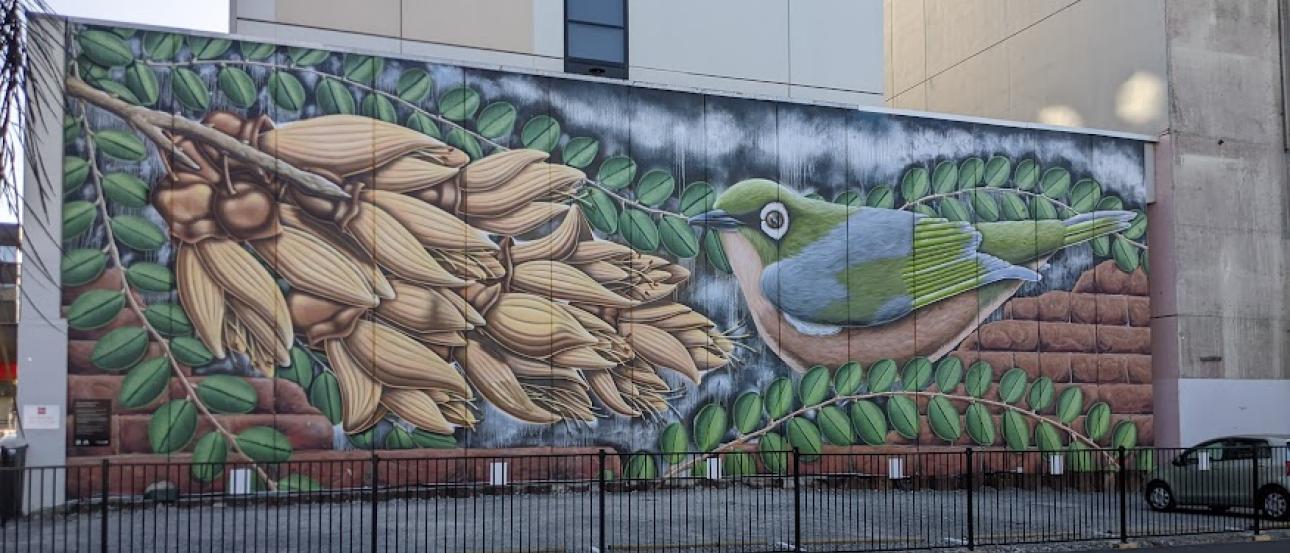Kia ora! My first month in New Zealand has absolutely flown by, but it also feels like I’ve been here forever. I’m finally settled into a semi-routine, with classes, my internship, and study during the week, and trips out of Christchurch (or at least a short tramp) during the weekend. As much as I’ve started to feel at home here though, there are still things that continue to trip me up and remind me that I’m in a different country. Those instances have gradually gotten fewer and farther in between, but the first few weeks were full of them as I learned to navigate the culture here. This post (plus the next post, part 2) contains a few of the things I’ve learned, as well as some tips if you decide to pay a visit to Christchurch. I’ll try to do another blog later that is more specific to IES Abroad/student life, but I kept this one pretty general. So, in no particular order:
- Clothing
- How fancy?: I learned within the first week here that how dressed up you should be largely depends on the time of day. During the day, most people dress casually, although women will sometimes wear nicer pants and a cute top. T-shirts with shorts or jeans are totally acceptable though. BUT if you go out at night, you are expected to dress up. It doesn’t have to be over the top, but women are expected to wear nice pants/a skirt with a nice top or a dress, and men are expected to wear button downs and long pants. Some people go all out, but I was fine in nice black jeans and a plain t-shirt/tank top. You also must be wearing close-toed shoes; the only open-toed shoes that are acceptable are heels. If you choose to go out at night (which you should at least once because Christchurch has some awesome restaurants, dance clubs, pool bars, etc.) try to follow these norms, or you won’t be able to get into anywhere with a bouncer. Or at the very least, you’ll receive some teasing from the bouncer (like when a guy in our group was wearing khaki shorts and could only smile sheepishly when the bouncer said “ah, we’re doing shorts tonight are we?”). Another time someone in my group wasn’t allowed into a club because she was wearing Birkenstock sandals—which are on the nicer end of the sandal spectrum but apparently aren’t nice enough. My Converse platform tennis shoes were totally acceptable though.
- Bare feet: Like I said above, definitely not acceptable at night in a bar, but totally fine in a grocery store during the day. Between various cultural traditions and the fact that the ground is typically a lot more sanitary here than in the US, it’s very common to see people barefoot while out and about. At first it was a little surprising to see this in the produce aisle, but I’ve gotten used to it and I think it speaks to the very laid back Kiwi attitude overall.
- American-ness: I intentionally only brought subtle or unmarked clothing because I didn’t want to stand out as an obvious foreigner by wearing American brands or clothing with American place names. However, both of the above are everywhere here. As I sit outside the library writing this, I’ve seen someone with a Nike backpack, someone wearing Chicago basketball shorts, and multiple people with sweatshirts advertising American universities. And they’re all Kiwis! I guess I shouldn’t be too surprised when American media is so well known here, but it’s still frazzling to see a Kiwi wearing a Harley Davidson t-shirt.
- Raincoat: is a must have. Make sure it’s a good one (i.e. that it will hold up in a downpour and has a hood). Mine is long enough to cover down to my midthigh, which I highly recommend.
- Hiking boots: another must if you’re planning to do any tramping at all outside of very easy treks. I have found the trails here to be a lot more rugged than in the US, even those categorized as easy or moderate. Having a reliable, waterproof pair of boots is something you will never regret here.
- General weather: The Kiwi/Australian band Crowded House has a famous song called Four Seasons In One Day, and I’ve heard two Kiwis use that song (accurately) to describe the weather here. All this morning it was pouring rain and chilly, and then within an hour the sun came out and now there’s not a cloud in the sky. So whatever you choose to wear, make sure you have some other options on hand (wear layers!). And be sure to always be prepared for rain, even if it’s sunny and 80°F when you leave the house.
- Sun: Something that I didn’t know until I did my pre-departure orientation is that there is a hole in the ozone layer over NZ. Which means the sun is a lot more intense than in the US. If you’re someone like me who is very prone to sunburn, beware! Even a short time in the sun can unexpectedly fry you (like when I got a mini sunburn on my scalp from the sun shining through a hole in my bike helmet onto a section of the part in my hair). Even if you’re not prone to burning, the sun is still dangerous here. There’s a reason NZ has the second highest rate of skin cancer in the world (only behind Australia). You can avoid contributing to that statistic by making fashion statements with big floppy hats, sunglasses, and sun shirts, and by using good sunscreen. I recommend buying your sunscreen here; most US sunscreen doesn’t have a high enough SPF, and unlike in the US, buying SPF 30 versus SPF 50 will actually make a difference. The Kiwis I’ve talked to recommend the brand Nivea. Opposingly, apparently the Cancer Society sunscreen is to be avoided as it doesn’t work well, which seems ironic but is good to know. The only sunscreens I would recommend bringing from the US are mineral sunscreens (versus chemical). I have not been able to find any here and my understanding is they are the safest type of sunscreen for marine life if you’re planning to go into the ocean.
- Food
- General grocery recommendations: I want to give a shout-out to Emily Renne, an IES Abroad blogger from 2015, for bringing a few of these stores to my attention. I’ll recap those assessments and add some more. My overall recommendations for cheap groceries are Pak'nSave and/or Countdown. They are the place to go for dry/canned goods and household items like paper towels etc. There’s also a lot of great Asian markets in Christchurch if you want a greater variety and a better price on things like rice, ramen noodles, seaweed wrappers, etc. I checked out a place called Sunson Asian Food Market near the University last week and it was really good. You can typically find good produce there as well, although I personally recommend Grower’s Direct as a place with high quality (and reasonably priced) produce that’s also near the University. Lastly, if you’re looking for convenience and high quality (and are willing to pay slightly more) New World is the place to go. I find myself there often simply because it’s only a block and a half away from my Ilam Apartments, but it’s not the most economical option for all your groceries. It kind of reminds me of Safeway. The produce is usually a little higher quality, they have more health/allergy friendly food, and you know that what you buy there will usually be good, but you might have to pay a little more for it compared to the Walmart-esque brands at Pak ‘N Save. I did end up signing up for their member card though, which I recommend if you plan to shop there with any regularity. It’s free to sign up and maintain, and you get access to special deals as well as points that can be redeemed on future purchases.
- Buy in season/locally when possible: a lot of groceries can seem super expensive here, but it’s usually because they’re imported or not in season. If you take the time to find stuff that is made/currently grown in NZ, it will usually be a lot cheaper and more delicious. Like this week, Nashi pears (often called Asian pears) came into season. Even though I had never tried them before, I took a chance based on their good price and they’re amazing! Farmer’s markets are a great example of fresh, local food too, but occasionally their stuff is more expensive because it’s so fresh. However, you’re usually paying for what you’re getting, and there are a ton of great farmer’s markets all over the Christchurch area. A quick Google search should bring up a lot of them.
- Eggs: not refrigerated here! So if you’re wandering around the refrigerated section wondering where they are, it’s because they’re hiding in the dry goods aisles (usually near the bread). My understanding is that in the US eggs go through an additional processing step that removes their protective coating and requires them to be refrigerated. They don’t go through that here though, so it’s totally safe to leave them out at the store and out on your counter at home.
- Sugar: It turns out that the US puts a lot of sweeteners in food and even other products you might not think about, like toothpaste. This meant that some stuff tasted kind of weird here at first, mainly because I was tasting the actual ingredients without a layer of sweetness over them. Gradually I’ve adjusted and honestly I prefer it the NZ way. For example, cereals and granola bars feel more wholesome and filling (although I don’t personally recommend Wheet-Bix; to me it’s like soggy bran/corn flakes that have been pushed into a rectangle and then left to dry out again. My apologies to NZ’s #1 cereal, I just don’t care for them.). As I get used to less sugar, other things are gradually tasting sweeter. Bell peppers are basically like candy now! That might be a slight exaggeration, but I really have noticed a change in how things taste, and I enjoy food more because of it.
- BBQ: Similarly to the US, this is a popular meal here for casual, large gatherings. That is where the similarities end though. Instead of ribs or burgers or hotdogs, Kiwi BBQs use a grill to cook large sausages and veggie patties. Instead of buns, plain pieces of the most basic white bread are used. You just grab a piece out of the bag and they plop your chosen protein on top. Then there are bottles of what look like ketchup but are actually a slightly different tomato-based sauce. I haven’t been able to figure out exactly what’s in it, but it’s less sweet and more tangy? Also there’s no BBQ sauce in sight, but you will probably find cans of either Fresh-Up fruit juice or L&P, an iconic NZ soda that reminds me of Sprite.
- Contact lens solution: Obviously this isn’t a food, but I wanted to include it for my fellow contacts wearers. I guess a lot of Kiwis don’t have my blind-as-a-bat-in-the-sun vision, or they just wear glasses, because solution was strangely difficult to find here. Even full pharmacy isles with everything from toothpaste to pain meds to even eye drops didn’t have contact lens solution. The only place I’ve been able to find it is at full pharmacies, like where you could get an actual prescription filled (the one I found was at a Countdown). So if you rely on contacts, be sure to bring a full travel bottle of solution to hold you over until you can find some here.
Who knew I could talk about clothing and food so much? It really emphasizes how significant those both are to a culture, and how noticeable it is when those things are even slightly different than what you’re used to. One of the most useful skills I’ve learned when traveling though is to just roll with the differences. After all, you’re the visitor, and part of the experience is noticing differences and then doing your best to adopt and adapt to them.
I will post a part 2 of my crash course soon, detailing some of the ups and downs of transportation in Christchurch and NZ. Until then, eat some good food, wear some comfy clothes, and if you’re in the US, keep those eggs in the fridge.

Anna Marie Riner
Kia ora! My name is Anna Marie, and I am a creative, outdoorsy individual from the Black Hills in South Dakota. This semester, I'm excited to be crossing the globe to New Zealand for some studying, tramping (hiking), eating, birding, interning, exploring and much more.







